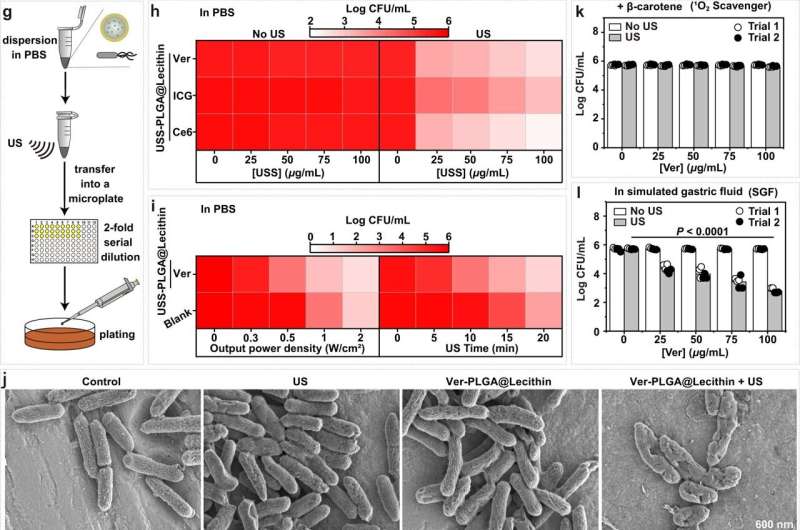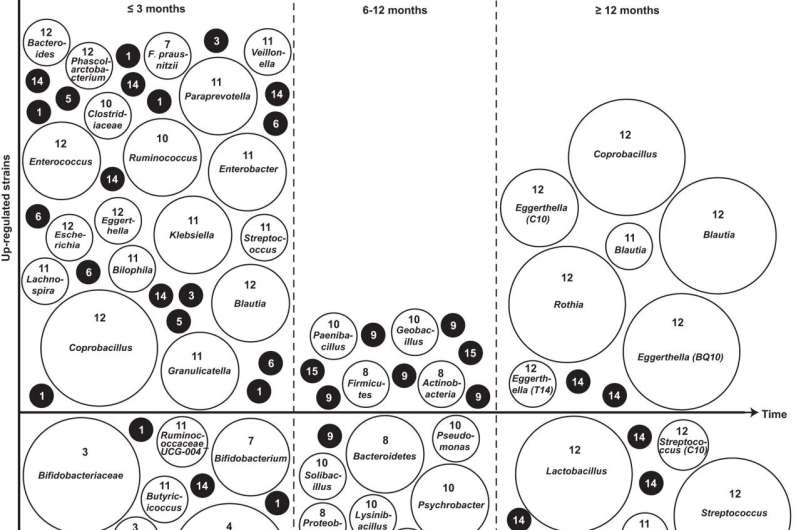
Helicobacter pylori (H. pylori) is a common pathogen that can be transmitted from person to person. Long-term H. pylori infection has been recognized as a Class I human carcinogen. Currently, the standard clinical treatments for H. pylori infection (i.e., triple and quadruple therapy) rely on oral antibiotics to clear H. pylori from the stomach.
However, antibiotic resistance in H. pylori has led to an increase in the failure and recurrence rates of clinical treatments over the years. Oral antibiotics can lead to an imbalance of the intestinal flora. In addition, clinical standard therapies such as triple therapy ignore vacuolar toxin A, a vital virulence factor in H. pylori infection.
A research team led by Prof. Yang Lihua from Hefei National Research Center for Physical Sciences at the Microscale, the University of Science and Technology of China (USTC) of the Chinese Academy of Sciences, has developed a nanoparticle-based sonodynamic therapy to reduce H. pylori infection in mouse without disrupting gut microbiota. The study was published in Nature Communications.
The nanoparticles that mediate this sonodynamic therapy have been approved for clinical use and have dual efficacy in this therapy. The therapy neutralizes vacuolating cytotoxin A, a key virulence factor secreted by H. pylori, even without the presence of ultrasound.
When combined with an ultrasound exposure dosage that meets the criteria for the use of ultrasound medical devices, it kills H. pylori through the production of reactive oxygen species, offering the possibility of addressing antimicrobial drug resistance.

In female mouse models infected with H. pylori, this sonodynamic therapy worked comparably to the standard triple therapy when it came to lower gastric infections. Unlike antibiotic-based clinical standard therapies, it did not have a significant negative impact on the intestinal microbiota, except for an upregulation on mouse intestinal levels of Lactobacillus, a beneficial bacterium widely used in yogurt and probiotic products.
Besides, it did not adversely affect liver or kidney function or the overall health of the mice within 48 hours of treatment administration, consistent with the safety standard of triple therapy.
However, a significant difference in the levels of interleukin-1 receptor antagonist (IL-1RA), a protein that plays a key anti-inflammatory role in a variety of diseases, was observed at 12 weeks post-treatment: the triple therapy up-regulated serum IL-1RA levels in the mice, whereas the sonodynamic therapy did not.
This study presents a promising alternative to the current antibiotic-based therapies for H. pylori infection, offering a reduced risk of antimicrobial resistance and minimal disturbance to the gut microbiota.
More information:
Tao Liu et al, A nanoparticle-based sonodynamic therapy reduces Helicobacter pylori infection in mouse without disrupting gut microbiota, Nature Communications (2024). DOI: 10.1038/s41467-024-45156-8
Provided by
University of Science and Technology of China

READ MORE
Can Physicists Ever Prove the Multiverse Is Real?
This is a hypothetical set of possible universes. Detlev Van Ravenswaay/Science Photo Library/Corbis The universe [...]
What is a Phillips head screwdriver?
In the 1930s, the auto industry was beginning to boom, and cars were being produced [...]
Umbrella for atoms: The first protective layer for 2D quantum materials
The band structure of pristine and graphene capped indenene. ARPES of a pristine monolayer indium [...]
Artificial DNA structures fitted with antibodies may instruct the immune system to target cancerous cells
Schematic of a multispecific antibody chassis variant library created from a set of antibody–DNA conjugates. [...]
5 Discoveries Made by the Large Hadron Collider (So Far)
Sometimes the machine charged with facilitating head-spinning discoveries needs a little downtime. Here, a maintenance [...]
Rossby Waves Affect Our Weather and Tides, But What Are They?
The jet stream that circles Earth’s North Pole travels west to east. But when the [...]
Does Bug Spray Expire?
Your bug spray from last summer? It’s probably still good. RealPeopleGroup/Getty Images Key Takeaways Bug [...]
How to Paint Drywall
It’s easy to make mistakes when painting drywall — if you don’t prepare correctly. See [...]